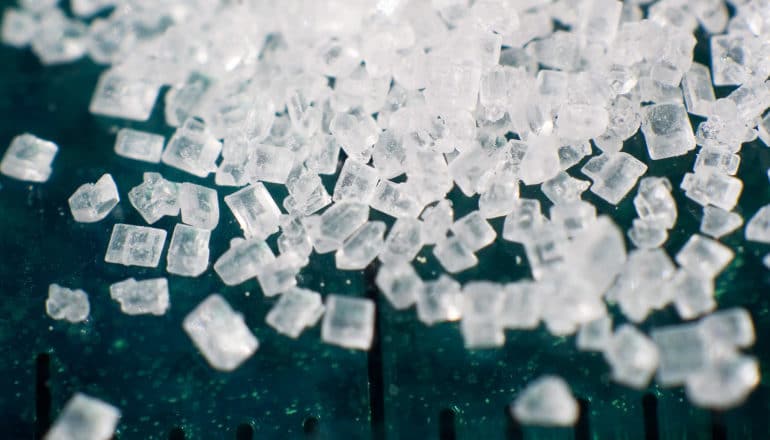
A simple method of synthesizing carbohydrates widens the range of labs that can use synthetic chemistry to generate and study novel carbohydrate structures.
Carbohydrates are complex molecules, difficult to synthesize in the lab, but doing so is useful in studying beneficial sugars such as those found in human breast milk, or enabling researchers to tailor the chemical structure of drug candidates, vaccines, and natural products.
The work appears in the Journal of the American Chemical Society.
“Nucleic acids, proteins, and carbohydrates are three of the basic building blocks you learn about in your biology classes,” says lead author John Montgomery, professor of chemistry and medicinal chemistry at the University of Michigan. “Chemistry has been able to automate the preparation of nucleic acids and proteins to where accessing these structures is routine, but carbohydrates are orders of magnitude more difficult to prepare. There are some incredible advances being made in the automation of carbohydrate synthesis, but the fact remains that this is tough chemistry that is holding back advances in glycobiology.”
Carbohydrates are complex
Carbohydrates have great structural diversity, complex branching patterns, and 3D architecture that hinder scientists’ ability to synthesize the compounds, says Montgomery. By using a silicon group to pre-engineer how carbohydrates will react with each other, the team’s method is able to control the carbohydrate’s branching pattern and reduce the steps required to access more complex structures.
For example, carbohydrate molecules typically consist of carbon, hydrogen, oxygen, and sometimes nitrogen atoms and range in length, with five- and six-carbon sugars being most prevalent. Most of the carbon atoms have an alcohol group, which can be connected to the next carbohydrate in a myriad of possible patterns.
“This branching feature is what makes synthetic chemistry very tedious because you have to control the selectivity between what part of the molecule is going to react with the next,” Montgomery says.
To control how those alcohol groups click carbohydrates together, Montgomery and his team put silicon “protecting groups” on select alcohols within a carbohydrate.
“Normally protecting groups need to be taken on and off during the synthesis, adding time and cost to the procedure. Our strategy is designed so that the protecting group naturally falls off during the coupling reaction and times the sequence of which alcohol group reacts when desired,” Montgomery says. “By this approach, we can reverse the reactivity of two alcohols, or we can take two alcohols that would normally have similar reactivity and make one react selectively over the other without additional steps.”
Then, the researchers can control the carbohydrate’s stereochemistry—the three-dimensional arrangement of the carbohydrate molecule—by making reactions between carbohydrates either intermolecular or intramolecular. If the reaction is intermolecular, that means the reaction occurs between two different molecules. If the reaction is intramolecular, that means a single molecule is assembled in which the two sugars are connected through silicon before the reaction.
Both the branching pattern and stereochemistry of the carbohydrate impact the sugar’s overall three-dimensional architecture, but this structural aspect also presents difficulty for synthesizing the sugars.
Because sugar molecules are so complex, there’s an “enormous number of statistically possible combinations if you had five sugars, for example,” Montgomery says. “The number can be in the billions of combinations even for these relatively short carbohydrate chains. That diversity is what makes carbohydrates so special for molecular recognition in nature, but it also makes the synthesis extremely tough.”
Fewer steps for synthesizing carbohydrates
The team’s method is particularly useful because using the silicon control feature allows the researchers to reduce the number of separate reactions to make a chain of carbohydrates in a single step. In this approach, the silicon control element allows the reactions to occur with three different sugars in the proper sequence so that a trisaccharide can be synthesized in one synthetic step. Those small groupings can then be further connected to access more complex chains in a very rapid fashion.
“You can set up multiple reactive possibilities and make them cascade in the proper sequence,” Montgomery says. “Things that you would normally run in a series of separated reactions—we can use that silicon control element to basically make it all happen in the reaction flask at once. We are still improving this aspect with new catalyst structures, but I think the strategy has the potential to be very powerful.”
Computational collaborator Paul Zimmerman, a coauthor of the study and professor of chemistry, is providing insights into how the process works and how to improve it.
Finally, traditional methods of linking carbohydrates together are very water sensitive and temperature sensitive. The team’s method uses commercial reagents that can be used without purification or drying to induce chemical reactions, and performed all of its procedures at room temperature.
Montgomery’s research had support from the National Institutes of Health Common Fund’s Glycoscience program. Montgomery and the university have submitted a provisional patent application on this work.
Source: University of Michigan
The post Method makes it easier to build carbs in the lab appeared first on Futurity.
from Futurity https://ift.tt/2xeC3zx
No comments:
Post a Comment